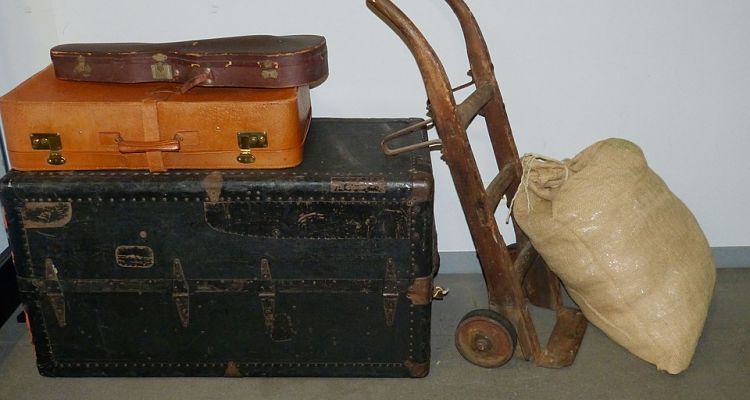
Many people choose to forgo hiring movers and instead opt to load a truck themselves when moving. As many people are aware, renting a truck and moving on your own can result in significant cost savings. Not only does this save money, but you are also saving a lot of time as well.
With a do it yourself move it means that you are also going at your own pace, so this means that you are never rushed to get your items all packed up and ready to go. Rather, you can take days or maybe weeks in advance to get everything together in preparation for a move.
Guide to Loading a Moving Truck Yourself
For some of you, your DIY moving project may be a first-time effort, and so you may be a bit in the dark as to how you should pack your household items in the truck to ensure that they arrive safely at your new location. With a DIY project such as this, there are risks involved. First, there is no moving insurance involved here and there is no one to blame but yourself should the items get damaged or destroyed either. With that said, here are a few moving tips that you can use for packing and securing your items in the truck.
Determine The Truck Size
One of the first things you want to do is to evaluate the number of items that you have in your home and select the right size truck for the moving project. For a local move, you might not need as large a truck but don’t underestimate how much space your belongings can take up. You want to select a truck that you can fit everything in quite comfortably and not pick a vehicle that would have too much space left over. If you choose a truck that is too big, what could happen is that your items would eventually slide all over the truck’s storage area as it moves, and this could ultimately cause damage to your items.
Get Enough Boxes and Supplies
Make sure to get all moving supplies before starting to load a moving truck. You will need a dolly for big goods and furniture pads or blankets to give extra protection while the truck is being transported, in addition to sturdy boxes, plastic wrap, and packing tape.
Take Apart Your Big Pieces
Packing a moving truck requires careful planning and organization to ensure that all items are loaded safely and efficiently. Before starting to load your furniture onto a moving truck, if it’s possible, take apart large and bulky pieces. This will help you make the most of your space and appropriately disperse the weight of any heavy furniture. For instance, removing the legs will allow you to keep a dining table upright without the legs sticking out. This will make more room for your goods and allow you to distribute the weight of the table legs across a wider area of the vehicle.
Rent The Moving Truck
When organizing your next move, there are several moving truck rental agencies to select from and you can find their branches in all major cities. Make sure to select the option that best suits your demands and budget. Penske, U-Haul, and Budget are the major truck rental companies to take into account. Comparing truck rentals from different companies can give you a better idea of what fits your budget and needs.
How to Vet Your Truck Rental Company
Inquire About Maintenance and Safety Records: Before you even think about signing anything, ask the company about their maintenance routines and safety records for their fleet. A well-maintained truck is not just a convenience; it’s a necessity for a safe move. Companies that regularly service their vehicles and can provide safety records are generally more reliable and should be considered more favorably.
Read Reviews and Ask for References: You wouldn’t buy a car without reading reviews, right? Do the same for your truck rental company. Look for reviews that specifically talk about the cleanliness of the trucks, customer service, and reliability. If you can, get a reference or two. Real experiences from real people can give you the inside scoop on what to expect.
Hidden Fees and Mileage: The devil’s in the details. Some companies lure you in with a low daily rate but then hit you with a ton of extra fees. Ask upfront about mileage limits, late return fees, and any other costs that might not be obvious. Make sure to get all this in writing; you’ll thank yourself later.
Inspect the Truck Before Signing: Before you put pen to paper, do a thorough inspection of the truck. Check for any existing damage and make sure it’s noted in your rental agreement. Test the locks, lights, and, yes, even the horn. You want to be fully aware of what you’re getting into—literally. Take photos of the truck’s interior before and after loading to have a record in case of disputes or damage claims.
The Hidden Costs of DIY Truck Rental
Let’s pull back the curtain on some of those sneaky expenses that can catch you off guard. Trust me, you’ll want to know these to avoid any unpleasant surprises on your final bill.
First up, mileage fees. Most rental companies offer what seems like a flat rate, but read the fine print. Often, you’ll find that you’re allocated a certain number of miles and if you go over that, you’re charged per extra mile. And those miles can add up quickly, especially if you’re making a long-distance move.
For long-distance moves, it’s crucial to plan your route carefully, taking into account rest stops and fuel stations. Another cost that’s easy to overlook is late return fees. Think you can just drop the truck off whenever? Think again. Returning the truck even an hour late could result in a full extra day’s charge.
You might assume your existing auto policy will cover a rental truck, but many plans don’t include this type of vehicle. While rental companies do provide their own insurance options, they’re rarely budget-friendly. Expect to pay between $20 and $60 per day for basic protection. Keep in mind that without coverage, you’ll be on the hook for any damages to the truck or your possessions. Before hitting the road, factor these hidden expenses into your budget. It’s wiser to plan ahead than to face unexpected costs later. Keep track of all moving costs, including packing materials and gas, to avoid any financial surprises.
Start Loading
There are some things that are never permitted, whether you hire professional movers or pack the moving truck yourself. It’s critical to become familiar with what cannot be loaded in advance to prevent delays on a moving day.
Next, load up the truck with the heaviest items that you have. By doing this, you are helping to steady the truck as you travel to your new home. Experts say that it is always best to place the items that you frequently use at the front of the truck’s storage area so that you would have easy access to them. Also at the front wall of the truck, you should pack the heaviest items such as your refrigerator, sofas, large cabinets, etc.
Your dining room chairs, bookcases and tables, and other such lighter items should be packed to the back of the truck’s storage unit and at the walls of the truck, you should put your mattresses, tabletops, box springs, and mirrors in an upright position.
Before securing them tightly with a rope, you should cover up your mattresses and sofa to prevent them from getting dirty or damaged as the truck starts to move. Mirrors and pictures should also be protected with pads or some other protective material as well. And when it comes to packing your boxes onto a truck, you should load the lighter ones on top of the heavier ones. By the time you have completed loading the truck, items should be tightly stacked so that they would not be swaying this way by the time the truck is ready to pull off.
Packing fragile items
Glassware, art, and electronics are examples of fragile items that should be packed in sturdy boxes and wrapped in bubble wrap and packing paper. Start by packing the box with padding materials, then wrap each item in bubble wrap. To keep things from moving during transportation, stuff any empty spaces with packing paper. The boxes should be marked as fragile and have an arrow pointing in the direction of the end that needs to be maintained upright. To offer more protection, think about using dish packs or specialized boxes made for fragile pieces.
It’s a good idea to stack fragile things on top of other items in the truck to further secure them during transit. This is referred to as the “top load method,” and it entails loading big, bulky things like furniture and appliances first, then piling smaller, more delicate ones on top. Understanding the moving process in detail can help you avoid common pitfalls, such as underestimating the amount of packing material you’ll need.
How to distribute the truck load weight evenly?
Proper distribution of the truckload is crucial for a safe and efficient move. Starting with the heavy things, equally, distribute them from side to side on the truck’s floor. In order to maintain a balanced weight, stack lighter things on top of heavier ones. For maximum stability during transit, pack your cargo solidly and securely. Make sure the weight is spread evenly once more, and make any required adjustments, before fastening the load.
Securing items for a bump-free journey
Properly securing your belongings is like putting on a seatbelt; it’s a non-negotiable step to ensure a safe journey. The key players here are ropes, straps, and other securing materials. These aren’t just add-ons; they’re essentials. Ropes made of nylon or polyester are durable and can handle heavy loads. Use them to tie down large furniture pieces to the truck’s anchor points. Ratchet straps are another lifesaver. They’re easy to tighten and can secure items more firmly than ropes.
But it’s not just about having the right tools; it’s about using them effectively. When tying down your items, make sure to loop the rope or strap through the anchor points in the truck, not just around the items. This creates a more stable setup. Also, consider the physics: distribute the tension evenly so that items don’t shift during sharp turns or sudden stops. For those fragile items, consider using bungee cords to secure the boxes in place. They offer a bit of flexibility, reducing the impact of bumps and jolts. By the end of this, you’ll not only have packed your truck but also engineered a secure setup that would make even a seasoned trucker nod in approval.
Don’ts of loading a truck for a move
Overloading the truck is among the most crucial no-nos. Make sure to confirm the truck’s weight limit and refrain from going over it. The tires and suspension may be strained as a result of overloading, which could also result in dangerous driving conditions and even property damage.
Certain items are prohibited from loading for safety or legal reasons. For instance, it is strictly forbidden to transport flammable or dangerous items like gasoline, propane tanks, or fireworks on moving trucks. This is because of the serious fire or explosion risk they present when being transported. Perishable items, such as food, plants, or animals, are also often prohibited since they can spoil or perish while in transit. The Environmental Protection Agency (EPA) recommends disposing of hazardous materials properly before moving, as they can’t be transported in rental trucks.
How long it takes on average to load a truck?
Many factors, including the size of the truck, the number of things being transported, the number of people, and the level of planning done beforehand, can affect how long it takes to load a moving truck. A 10-foot moving truck can typically be loaded in 2-4 hours, a 16-foot moving truck in 3-5 hours, and a 26-foot moving truck in 4-6 hours.
However, these are generally ballpark figures, and the actual time needed may change depending on the details of the move. To ensure a quick and easy loading process, it’s usually a good idea to give yourself plenty of time and plan ahead.
Avoid Injuries When You Lift and Pack
Loading your moving truck can be a physically demanding task, so it’s important to use proper lifting techniques and enlist the help of others if needed to prevent injury. The Bureau of Labor Statistics reports that overexertion, including lifting or lowering, accounts for about 31% of work-related injuries. Using safe lifting techniques, such as bending at the knees and maintaining a straight back when carrying heavy items, is one way to prevent injuries. When moving big items, think about using a hand truck or a dolly, and ask a friend or family member for assistance with lifting and carrying. Investing in quality moving equipment like furniture dollies and hand trucks can make the loading and unloading phases much smoother.
Another method to lessen the physical strain when loading into the truck is to use a ramp or loading dock. Wear cozy, non-slip footwear, and stay away from loose apparel that might get snagged on anything. Finally, to avoid muscle soreness and exhaustion, take regular pauses and drink plenty of water.
Understanding the Legalities of DIY Moving
Have you considered the legal side of your DIY move? It’s not just about boxes and bubble wrap; overlooking legal requirements can land you in hot water, from hefty fines to legal disputes. For starters, some states require permits for moving trucks, especially for larger sizes. Make sure you’re aware of the road weight limits in the areas you’ll be driving through. Exceeding these limits can result in fines and can even impede your move if you’re pulled over for an inspection.
Yet that’s just the beginning. Regulations specific to each state could also complicate your move. For instance, some states prohibit the transport of plants across their borders due to agricultural rules, while others may require declarations for large sums of money or valuable goods. It’s advisable to consult the Department of Transportation website or seek advice from legal experts to ensure full compliance. Trust us, encountering unforeseen legal hurdles mid-move is something you’ll want to avoid.
In conclusion, loading a truck by yourself can take a lot of physical effort and time, but it can also be a satisfying experience. Your cargo will be properly secured and protected throughout travel if you take the time to prepare and organize the loading process.
Taking safety measures is equally important when unloading to avoid accidents and damage. You may safely finish the job and effectively move your possessions to their destination by following these tips.




Leave a Comment